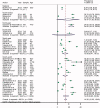Estimating the prevalence of overweight and obesity in Nigeria in 2020: a systematic review and meta-analysis
- PMID: 33783281
- PMCID: PMC8018557
- DOI: 10.1080/07853890.2021.1897665
Estimating the prevalence of overweight and obesity in Nigeria in 2020: a systematic review and meta-analysis
Abstract
Background: Targeted public health response to obesity in Nigeria is relatively low due to limited epidemiologic understanding. We aimed to estimate nationwide and sub-national prevalence of overweight and obesity in the adult Nigerian population.
Methods: MEDLINE, EMBASE, Global Health, and Africa Journals Online were systematically searched for relevant epidemiologic studies in Nigeria published on or after 01 January 1990. We assessed quality of studies and conducted a random-effects meta-analysis on extracted crude prevalence rates. Using a meta-regression model, we estimated the number of overweight and obese persons in Nigeria in the year 2020.
Results: From 35 studies (n = 52,816), the pooled crude prevalence rates of overweight and obesity in Nigeria were 25.0% (95% confidence interval, CI: 20.4-29.6) and 14.3% (95% CI: 12.0-15.5), respectively. The prevalence in women was higher compared to men at 25.5% (95% CI: 17.1-34.0) versus 25.2% (95% CI: 18.0-32.4) for overweight, and 19.8% (95% CI: 3.9-25.6) versus 12.9% (95% CI: 9.1-16.7) for obesity, respectively. The pooled mean body mass index (BMI) and waist circumference were 25.6 kg/m2 and 86.5 cm, respectively. We estimated that there were 21 million and 12 million overweight and obese persons in the Nigerian population aged 15 years or more in 2020, accounting for an age-adjusted prevalence of 20.3% and 11.6%, respectively. The prevalence rates of overweight and obesity were consistently higher among urban dwellers (27.2% and 14.4%) compared to rural dwellers (16.4% and 12.1%).
Conclusions: Our findings suggest a high prevalence of overweight and obesity in Nigeria. This is marked in urban Nigeria and among women, which may in part be due to widespread sedentary lifestyles and a surge in processed food outlets, largely reflective of a trend across many African settings.KEY MESSAGESAbout 12 million persons in Nigeria were estimated to be obese in 2020, with prevalence considerably higher among women. Nutritional and epidemiological transitions driven by demographic changes, rising income, urbanization, unhealthy lifestyles, and consumption of highly processed diets appear to be driving an obesity epidemic in the country.
Keywords: Nigeria; Obesity; epidemiology; non-communicable diseases; overweight; prevalence.
Conflict of interest statement
The authors declare no conflicts of interest.
Figures




Similar articles
-
Urban-rural and geographic differences in overweight and obesity in four sub-Saharan African adult populations: a multi-country cross-sectional study.BMC Public Health. 2016 Oct 28;16(1):1126. doi: 10.1186/s12889-016-3789-z. BMC Public Health. 2016. PMID: 27793143 Free PMC article.
-
Prevalence and trends of adult overweight and obesity in Nigeria - A systematic review and meta-analysis.Niger J Clin Pract. 2023 Jan;26(1):1-15. doi: 10.4103/njcp.njcp_1903_21. Niger J Clin Pract. 2023. PMID: 36751817
-
Prevalence of hypercholesterolemia in Nigeria: a systematic review and meta-analysis.Public Health. 2020 Jan;178:167-178. doi: 10.1016/j.puhe.2019.09.002. Epub 2019 Nov 5. Public Health. 2020. PMID: 31698139 Free PMC article.
-
Body-mass index and obesity in urban and rural China: findings from consecutive nationally representative surveys during 2004-18.Lancet. 2021 Jul 3;398(10294):53-63. doi: 10.1016/S0140-6736(21)00798-4. Lancet. 2021. PMID: 34217401 Free PMC article.
-
[The prevalence of obesity in various socio-demographic groups of the population of Russia].Vopr Pitan. 2021;90(3):67-76. doi: 10.33029/0042-8833-2021-90-3-67-76. Epub 2021 May 17. Vopr Pitan. 2021. PMID: 34264558 Russian.
Cited by
-
Zero malaria: a mirage or reality for populations of sub-Saharan Africa in health transition.Malar J. 2022 Nov 4;21(1):314. doi: 10.1186/s12936-022-04340-1. Malar J. 2022. PMID: 36333802 Free PMC article. Review.
-
Socio-demographic and Nutritional Factors Associated with Obesity amongst Adults from High Burden Kidney Diseases Areas of Jigawa State, Nigeria: A Community-based Survey.Niger Med J. 2024 Feb 22;64(6):799-815. doi: 10.60787/nmj-64-6-388. eCollection 2023 Nov-Dec. Niger Med J. 2024. PMID: 38979057 Free PMC article.
-
Clinical characteristics and classification of Cameroonians with obesity and metabolically normal phenotype in the West region of Cameroon.Heliyon. 2022 Nov 17;8(11):e11652. doi: 10.1016/j.heliyon.2022.e11652. eCollection 2022 Nov. Heliyon. 2022. PMID: 36425423 Free PMC article.
-
Prevalence and characteristics of metabolic syndrome and its components among adults living with and without HIV in Nigeria: a single-center study.BMC Endocr Disord. 2023 Jul 28;23(1):160. doi: 10.1186/s12902-023-01419-x. BMC Endocr Disord. 2023. PMID: 37507703 Free PMC article.
-
Multilevel Analysis of Urban-Rural Variations of Body Weights and Individual-Level Factors among Women of Childbearing Age in Nigeria and South Africa: A Cross-Sectional Survey.Int J Environ Res Public Health. 2021 Dec 23;19(1):125. doi: 10.3390/ijerph19010125. Int J Environ Res Public Health. 2021. PMID: 35010382 Free PMC article.
References
-
- World Health Organization . Overweight and obesity. Geneva: World Health Organization; 2018. Available from: https://www.who.int/news-room/fact-sheets/detail/obesity-and-overweight
-
- Forouzanfar MH, Afshin A, Alexander LT, et al. . Global, regional, and national comparative risk assessment of 79 behavioural, environmental and occupational, and metabolic risks or clusters of risks, 1990-2015: a systematic analysis for the Global Burden of Disease Study 2015. Lancet. 2016;388(10053):1659–1724. - PMC - PubMed
-
- Ford ND, Patel SA, Narayan KV.. Obesity in low- and middle-income countries: burden, drivers, and emerging challenges. Annu Rev Public Health. 2017;38:145–164. - PubMed
-
- Steyn NP, Mchiza ZJ.. Obesity and the nutrition transition in Sub-Saharan Africa. Ann N Y Acad Sci. 2014;1311(1):88–101. - PubMed
Publication types
MeSH terms
Grants and funding
LinkOut - more resources
Full Text Sources
Other Literature Sources
Medical
